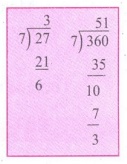Statistics | Term 3 Chapter 5 | 7th Maths - Arithmetic Mean | 7th Maths : Term 3 Unit 5 : Statistics
Chapter: 7th Maths : Term 3 Unit 5 : Statistics
Arithmetic Mean
Arithmetic Mean
Now, let us see one of the measures of
central tendency, that is the Arithmetic Mean. Consider this situation.
Mani and Ravi started collecting shells
in the sea shore with an agreement to share the shells equally after collection.
Finally, Mani collected 50 shells and Ravi collected 30 shells. Now, if both of
them share equally, find the number of shells each one gets?
We find it using arithmetic mean or average.To
find the average, add the numbers and divide by Hence,
Average = [50+ 30]/2 = 80/2 = 40
Average lies between 30 and 50.
Hence, each of them will get 40.
Thus to find the arithmetic mean (average),
we have to add all the observations and divide the sum of all observations by the
number of observations.
Hence, Arithmetic Mean = Sum of all observations/Number of observations.
Try these
Find the Arithmetic Mean or average of the following data.
(i) The study time spent by Kathir in a week is 3 hrs, 4 hrs, 5 hrs,
3 hrs, 4 hrs, 3:45 hrs; 4:15 hrs.
Arithmetic Mean = Sum of all observations / Number of
observations
= [ 3 + 4 + 5 + 3 + 4 + 3.45 + 4.15 ] / 7
= 27 / 7 = 3 hrs 52 min
Mean = 3 : 52 hrs

(ii) The marks scored by Muhil in five subjects are 75, 91, 48, 63,
51.
Solution:
Arithmetic Mean = Sum of all observations / Number of
observations
= [ 75 + 91+ 48 + 63 + 51 ] / 5 = 328 / 5
Arithmetic mean = 65.6
(iii) Money spent on vegetables for five days is ₹ 120, ₹ 80, ₹ 75,
₹ 95 and ₹ 86.
Solution:
Arithmetic Mean = Sum of observations / Number of observations
= [120 + 80 + 75 + 95 + 86] / 5 = 456 / 5
Arithmetic Mean = 91.2
Example 5.1
The daily wages of a worker
for 10 days is as follows. Find the average income of the worker.

Solution:

Arithmetic
Mean = Sum of all observations /Number of observations
= [ 250 + 350 + 100 + 400 + 150 + 270
+ 450 + 320 + 610 + 750 ] /10
= 3650/10 = 365
Hence, the average income of the worker
is ₹ 365.
Example 5.2
The mean of 9 observations is 24. Find
the sum of the 9 observations.
Solution:
Arithmetic
Mean = Sum of all observations / Number of observations

Thus, 24 = Sum of all observations /
9
Sum of all observations = 9×24= 216.
Example 5.3
The mean age of 15 teachers in a school is 42. The ages of the teachers
are 35, 42, 48, X, X+8, 40, 43,
50, 46, 50, 37, 32, 38, 41, 40 (in years). Find the value of X and unknown ages
of the two teachers?
Solution:
Mean
= Total ages of teachers/Number of teachers

42 = [ 35+42+48+ X +(X+8)+40+43+50+46+50+37+32+38+41+40
] / 15
[550+2X ] /15 = 42
550 + 2X = 42 ×15
= 630
2X = 630 − 550
2X=80
X=80/2
X=40
Therefore, the age of the teacher (X)
is 40 and the age of the another teacher (X+8) is 40+8=48.
Example 5.4
If the mean of the following numbers
is 38, find the value of x.
48, x, 37, 38, 36, 27, 35, 34, 38, 49, 33.
Solution:
Mean
= Sum of all observations /Number of observations

38 = [ 48 + x + 37 + 38 + 36 + 27 + 35 + 34 + 38 + 49 + 33] / 11
38 = [ 375 + x] / 11
38 × 11= 375 + x
418 = 375+x
x = 418 – 375
x = 43
Hence, the value of x is 43.
Think
Check the properties of
arithmetic mean for the example given below:

(i) If the mean is increased by 2, then what happens to the individual
observations.
Solution:
Given number are 3, 6, 9, 12, 15
Arithmetic Mean = Sum of observations / Number of observations
= [3 + 6 + 9 + 12 + 15] / 5 = 45 / 5 = 9
If mean is increased by 2 then,
9 + 2 = Sum of observations / 5
Sum of observations = 5 × 11 = 55
Difference in sum = 55 – 45 = 10
∴ Each number is increased by 2 if the mean is increased by 2.
(ii) If first two items
are increased by 3 and last two items are reduced by 3, then what will be the new
mean?
Solution:
If the first two items is increased by 3, then the numbers will
be
3 + 3, 6 + 3 => 6, 9.
If last two numbers are decreased by 3, then the numbers will be
12 – 3, 15 – 3 => 9, 12.
∴ Mean of new numbers = [ 6 + 9 + 9+ 9+ 12 ] / 5
= 45 / 9 = 9
There is no change in the mean.
Here are few interesting
averages.
1. On an average, you blink your eyes 17 times per minute. That is
5.2 million times a year.
2. The average person has about 1460 dreams a year. That is about
4 per night.
3. Based on the average
life of a G2 star the present age of the sun is estimated to be 4.5 billion years,
halfway through its lifetime.
Related Topics